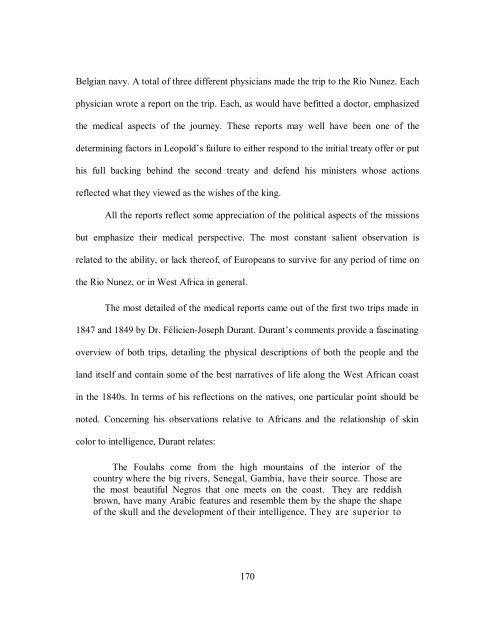EARLY BELGIAN COLONIAL EFFORTS - The University of Texas at ...
EARLY BELGIAN COLONIAL EFFORTS - The University of Texas at ...
EARLY BELGIAN COLONIAL EFFORTS - The University of Texas at ...
Create successful ePaper yourself
Turn your PDF publications into a flip-book with our unique Google optimized e-Paper software.
Belgian navy. A total <strong>of</strong> three different physicians made the trip to the Rio Nunez. Each<br />
physician wrote a report on the trip. Each, as would have befitted a doctor, emphasized<br />
the medical aspects <strong>of</strong> the journey. <strong>The</strong>se reports may well have been one <strong>of</strong> the<br />
determining factors in Leopold’s failure to either respond to the initial tre<strong>at</strong>y <strong>of</strong>fer or put<br />
his full backing behind the second tre<strong>at</strong>y and defend his ministers whose actions<br />
reflected wh<strong>at</strong> they viewed as the wishes <strong>of</strong> the king.<br />
All the reports reflect some appreci<strong>at</strong>ion <strong>of</strong> the political aspects <strong>of</strong> the missions<br />
but emphasize their medical perspective. <strong>The</strong> most constant salient observ<strong>at</strong>ion is<br />
rel<strong>at</strong>ed to the ability, or lack there<strong>of</strong>, <strong>of</strong> Europeans to survive for any period <strong>of</strong> time on<br />
the Rio Nunez, or in West Africa in general.<br />
<strong>The</strong> most detailed <strong>of</strong> the medical reports came out <strong>of</strong> the first two trips made in<br />
1847 and 1849 by Dr. Félicien-Joseph Durant. Durant’s comments provide a fascin<strong>at</strong>ing<br />
overview <strong>of</strong> both trips, detailing the physical descriptions <strong>of</strong> both the people and the<br />
land itself and contain some <strong>of</strong> the best narr<strong>at</strong>ives <strong>of</strong> life along the West African coast<br />
in the 1840s. In terms <strong>of</strong> his reflections on the n<strong>at</strong>ives, one particular point should be<br />
noted. Concerning his observ<strong>at</strong>ions rel<strong>at</strong>ive to Africans and the rel<strong>at</strong>ionship <strong>of</strong> skin<br />
color to intelligence, Durant rel<strong>at</strong>es:<br />
<strong>The</strong> Foulahs come from the high mountains <strong>of</strong> the interior <strong>of</strong> the<br />
country where the big rivers, Senegal, Gambia, have their source. Those are<br />
the most beautiful Negros th<strong>at</strong> one meets on the coast. <strong>The</strong>y are reddish<br />
brown, have many Arabic fe<strong>at</strong>ures and resemble them by the shape the shape<br />
<strong>of</strong> the skull and the development <strong>of</strong> their intelligence. <strong>The</strong>y are superior to<br />
170
















